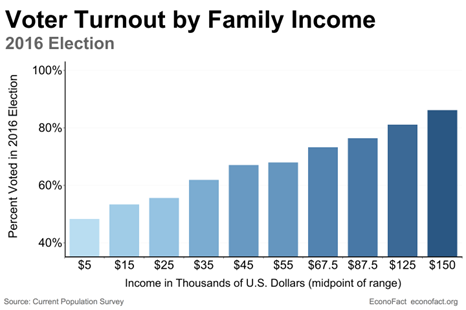The Daily Escape:

Aurora seen from Purgatory Overlook, Blue Ridge Parkway, VA on Sunday. The aurora was visible in 30 states on Sunday – April 2023 photo by Jason Rinehart
(Wrongo and Ms. Right are very happy for friend and blog reader Gloria R. who is making a great recovery from a life-threatening illness.)
Yesterday, Wrongo pointed out that independent voters were the fastest growing segment of the eligible voter population. With the partisan vote evenly divided between the two Parties, this means there are serious challenges ahead if either Party is to establish a sustainable majority with American voters.
But independents aren’t the only group we need to discuss. Doug Sosnik’s latest in the NYT talks about the “diploma divide”:
“…college educated voters are now more likely to identify as Democrats, and those without college degrees — particularly white voters….support Republicans.”
Sosnik says education level has become the single best predictor of how Americans will vote, and for whom.
Part of the reason for this shift is economic. According to the Federal Reserve Bank of St. Louis, since 1989, families headed by college graduates have increased their wealth by 83%, while for households headed by someone without a college degree, there was relatively little or no increase in wealth.
That has opened non-college homes to the grievance messaging of the Republican Party.
In the 2022 midterm elections, Democrats carried White voters with a college degree by three points, while Republicans won White non-college voters by 34 points, a 10-point improvement from 2018.
Today 42 states are firmly controlled by one Party. The only states that voted for the winning presidential candidates in both the 2016 and 2020 elections rank roughly in the middle on educational levels — Pennsylvania (23rd in education attainment), Georgia (24th), Wisconsin (26th), Arizona (30th) and Michigan (32nd).
Sosnik says that in 2024, Democrats are likely to enter the general election with 222 electoral votes, compared with 219 for Republicans. That means the presidency will be decided by whomever does best in just eight states, comprising 97 electoral votes: Arizona, Georgia, Michigan, New Hampshire, North Carolina, Nevada, Pennsylvania, and Wisconsin. Sosnik says that:
“…for these states, education levels are near the national average — not proportionately highly educated nor toward the bottom of attainment.”
This means that they are up for grabs by the Party with the stronger candidate and message. It also means that the Parties should look beyond education for like-minded voters in these states, so they should also focus on independents. Independent voters disproportionately live in suburbs. More from Sosnik:
“….the suburbs are the last battleground in American politics.”
We said yesterday that most of these independents are younger voters, millennials and Gen-Z. Many have also experienced weaker job markets than their elders, so they may be more disillusioned than most in the suburbs. So they are likely up for grabs.
Suburbs voting was decisive in determining the outcome of the last two presidential elections: Voters in the suburbs of Atlanta, Detroit, Milwaukee, Philadelphia, Pittsburgh and Phoenix helped determine the winner in those two presidential elections. They are likely to play the same role in 2024.
Since the 2024 presidential election will likely be won in those eight states, turnout is also a huge issue. Econofact says that richer people are more likely to vote than poorer people. The chart below shows turnout by income level for the 2016 presidential election:

The 48% voting participation rate for families in the lowest income category in 2016 was a little better than half of the 86% rate for families in the highest income category. Econofact states that the ratio of differences across income groups is similar for other election years as well.
Finally, there is an emergent anti-MAGA segment of the population. Michael Podhorzer writes a Substack newsletter about politics and economics. He says that:
“In 2016, despite losing the popular vote, Trump became president by virtue of his Electoral College victory. That election made clear that Arizona, Georgia, Michigan, Pennsylvania and Wisconsin had become the fulcrum of American politics.
In those five states, on the day that Trump was sworn in, only one state had a Democratic governor (Pennsylvania), only four Democrats served in the Senate, and Democrats did not constitute a majority in any of the 10 state legislative chambers.”
Now, four of the five governors are Democrats, nine of the ten Senators will be Democrats, and three of the state legislative chambers will have Democratic majorities. Podhorzer attributes this to Dems winning a big share of the anti-MAGA cohort.
It’s far too early to know how independents, or the non-college educated, or the relatively poorer Americans will vote in 2024.
But the winning Party had better be able to speak to and for the working classes.
Democrats say they’re a big tent, that all classes are welcome. They seem willing to back everything from trans rights to expanded Medicaid. But that messaging isn’t getting through to less educated, or to working class folks. They don’t believe it.
The Party’s political future requires Dems to speak up loudly on behalf of working men and women.

Democrats have to consider that their words can alienate voters who are not followers of the latest trends. For example, the language about transsexuals is absolutist (and includes terms like cis-gender and pregnant people) so of course folks who work for a living (and not as social workers) wonder where these ideas came from. Even seem put off.
So do ideas like white privilege. My grandfather was a Polish immigrant who died in a coal mine. I get it but it even sometimes grates on me.
In the communities where these concepts emerge everyone seems to be on board. But for the rest – well they become like someone who enters a cocktail party where all the men are in skinny suits and he is wearing a sweatshirt that say “Dad”.
Dems have a great message for the population that they cannot take for granted. That message has two parts; general policy positions/values and legislation, both first-term achievements and next term proposals. They need to emphasize these messages in the clearest terms possible and repeat them often. Don’t get trapped into culture-war disputes; just repeat those values. And don’t take any district for granted; make sure that seats are not lost because local Dem organizations sit on their hands as happened in ’22 in NY.
Terry is right about avoiding the leftish buzzwords that grate even on progressives like him and me. “Know your audience” is the first rule of communication. One does not “pander” when one avoids terms that may be toxic to some in your broad audience. One can be forthright without being careless.